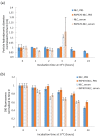Biodistribution of Nanostructured Lipid Carriers in Mice Atherosclerotic Model
- PMID: 31561608
- PMCID: PMC6803849
- DOI: 10.3390/molecules24193499
Biodistribution of Nanostructured Lipid Carriers in Mice Atherosclerotic Model
Abstract
Atherosclerosis is a major cardiovascular disease worldwide, that could benefit from innovative nanomedicine imaging tools and treatments. In this perspective, we here studied, by fluorescence imaging in ApoE-/- mice, the biodistribution of non-functionalized and RXP470.1-targeted nanostructured lipid carriers (NLC) loaded with DiD dye. RXP470.1 specifically binds to MMP12, a metalloprotease that is over-expressed by macrophages residing in atherosclerotic plaques. Physico-chemical characterizations showed that RXP-NLC (about 105 RXP470.1 moieties/particle) displayed similar features as non-functionalized NLC in terms of particle diameter (about 60-65 nm), surface charge (about -5 - -10 mV), and colloidal stability. In vitro inhibition assays demonstrated that RXP-NLC conserved a selectivity and affinity profile, which favored MMP-12. In vivo data indicated that NLC and RXP-NLC presented prolonged blood circulation and accumulation in atherosclerotic lesions in a few hours. Twenty-four hours after injection, particle uptake in atherosclerotic plaques of the brachiocephalic artery was similar for both nanoparticles, as assessed by ex vivo imaging. This suggests that the RXP470.1 coating did not significantly induce an active targeting of the nanoparticles within the plaques. Overall, NLCs appeared to be very promising nanovectors to efficiently and specifically deliver imaging agents or drugs in atherosclerotic lesions, opening avenues for new nanomedicine strategies for cardiovascular diseases.
Keywords: ApoE-/- model; active targeting.; atherosclerosis; lipid nanoparticles; macrophage elastase (MMP-12); nanomedicine.
Conflict of interest statement
The authors declare no conflict of interest.
Figures





Similar articles
-
Nanostructured lipid carriers accumulate in atherosclerotic plaques of ApoE-/- mice.Nanomedicine. 2020 Apr;25:102157. doi: 10.1016/j.nano.2020.102157. Epub 2020 Jan 23. Nanomedicine. 2020. PMID: 31982616
-
Nanostructured lipid carriers as novel drug delivery system for lung cancer gene therapy.Pharm Dev Technol. 2016;21(3):277-81. doi: 10.3109/10837450.2014.996900. Epub 2015 Jan 5. Pharm Dev Technol. 2016. PMID: 25560648
-
Transferrin-modified nanostructured lipid carriers as multifunctional nanomedicine for codelivery of DNA and doxorubicin.Int J Nanomedicine. 2014 Aug 25;9:4107-16. doi: 10.2147/IJN.S67770. eCollection 2014. Int J Nanomedicine. 2014. PMID: 25187713 Free PMC article.
-
Preparation, characterization and physico-chemical properties of solid lipid nanoparticles (SLN) and nanostructured lipid carriers (NLC): their benefits as colloidal drug carrier systems.Pharmazie. 2006 May;61(5):375-86. Pharmazie. 2006. PMID: 16724531 Review.
-
Lipid nanocarriers (LNC) and their applications in ocular drug delivery.Curr Med Chem. 2015;22(13):1589-602. doi: 10.2174/0929867322666150209152259. Curr Med Chem. 2015. PMID: 25666802 Review.
Cited by
-
Nanotechnology for cardiovascular diseases.Innovation (Camb). 2022 Feb 2;3(2):100214. doi: 10.1016/j.xinn.2022.100214. eCollection 2022 Mar 29. Innovation (Camb). 2022. PMID: 35243468 Free PMC article. Review.
-
Natural and Synthetic LDL-Based Imaging Probes for the Detection of Atherosclerotic Plaques.ACS Pharmacol Transl Sci. 2025 Feb 4;8(2):578-591. doi: 10.1021/acsptsci.4c00667. eCollection 2025 Feb 14. ACS Pharmacol Transl Sci. 2025. PMID: 39974638
-
Dual-Responsive Methotrexate-Human Serum Albumin Complex-Encapsulated Liposomes for Targeted and Enhanced Atherosclerosis Therapy.Int J Nanomedicine. 2025 Feb 21;20:2305-2322. doi: 10.2147/IJN.S502850. eCollection 2025. Int J Nanomedicine. 2025. PMID: 40007906 Free PMC article.
-
Oral Nanoformulations in Cardiovascular Medicine: Advances in Atherosclerosis Treatment.Pharmaceuticals (Basel). 2024 Jul 10;17(7):919. doi: 10.3390/ph17070919. Pharmaceuticals (Basel). 2024. PMID: 39065770 Free PMC article. Review.
-
Integrating Natural Deep Eutectic Solvents into Nanostructured Lipid Carriers: An Industrial Look.Pharmaceuticals (Basel). 2024 Jun 28;17(7):855. doi: 10.3390/ph17070855. Pharmaceuticals (Basel). 2024. PMID: 39065706 Free PMC article.
References
-
- Müller R.H., Shegokar R., Keck C.M. 20 years of lipid nanoparticles (SLN & NLC): Present state of development & industrial applications. Curr. Drug Discover. Technol. 2011;8:207–227. - PubMed
-
- Cavalli R., Marengo E., Rodriguez L., Gasco M.R. Effects of some experimental factors on the production process of solid lipid nanoparticles. Eur. J. Pharm. Biopharm. 1996;42:110–115.
MeSH terms
Substances
Grants and funding
LinkOut - more resources
Full Text Sources
Miscellaneous

